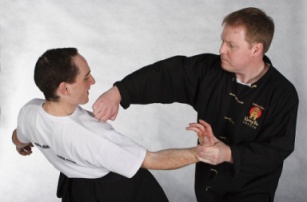The kung fu fighter’s hook punch, known in Chinese martial arts as the Qian Bai, is a very effective medium range striking technique. It is found in almost all Martial Arts and western forms of boxing, but its origins are diverse and its execution differs greatly depending on the practitioner’s style and influence. The following explanation of the Qian Bai is relevant to Chinese Kung Fu, more distinctly, to the style that is taught at the Golden Lion Academy.

The hook punch itself draws most of its power from this pivoting action, the front foot stays solid and grounded whilst the rear leg provides speed and power, along with the pivoting action which gives the practitioner better range and access to the opponent’s torso or head. This may sound complicated, but in practice, the motion is not difficult to grasp a basic understanding of- one of the most important things to remember is that the punch itself uses largely a static arm, that is, an arm that doesn’t provide a lot of movement within itself, but rather is propelled by the overall movement of the body.
Kung fu hook punch – common fault
A common problem with the hook punch is precisely that miscalculation, that the arm itself must move a great deal in order for the punch to be effective. This is untrue, and problematic for a number of reasons. Chiefly, many practitioners of Kung Fu are slight of frame and naturally more nimble bodied than heavy handed, this type of stature has been beneficial to the practitioner as it allows for speed of movement and greater agility. Therefore, a hook punch that relies solely on the strength of the shoulders and arm muscles is unlikely to produce a great deal of power or speed. Secondly, and of much greater significance when the practitioner is fighting an opponent of considerable skill, is the reality that a hook punch that moves a great deal, arching over a larger distance due to the high amount of movement in the arm itself, is very predictable and obvious to a skilled opponent.
The arm must naturally be pulled back, then arched away from the practitioner (leaving that arm useless for defending the body) and then flung forward with as much power as the shoulders can muster. This movement is quite slow and cumbersome, and the initial employment of it is obvious in both the movement of the shoulders and the retracting of the punching arm. Also, this type of approach to the hook punch fails to take advantage of the vast amounts of Chi and power that the rest of the body provides, indeed, it is like driving a car on one wheel only, rather than using all four wheels! This punch will be slow, sloppy and will undoubtedly lack power in all but the largest of practitioners.
The hook punch, therefore, represents the broader approach to kung fu in so many ways. It is a full body movement that utilises the Chi and power that a practitioner has built up from the heels of their feet to the top of their skull. A hook punch, used appropriately, is an excellent counter attack to a straight, linear attack, or even an excellent initial strike when used with the leading hand and combined with a full body pouncing action. The hook punch requires rigidity in the arm at the point of contact, but always with the combined suppleness in the rest of the body before the strike meets its target.
The Yin and Yang of Martial Arts is evident in this strike, the practitioner must be fast yet calculated, soft yet hard as steel, and move as if completely uninhibited yet totally focused and directed. A Qian Bai Chinese hook punch is an exceptionally effective tool that requires great contemplation, regular training and the correct approach in order to utilise it correctly, but when mastered properly it produces exceptional results.
Thanks to Adam Cantelmi – Berwick Kung Fu Centre
